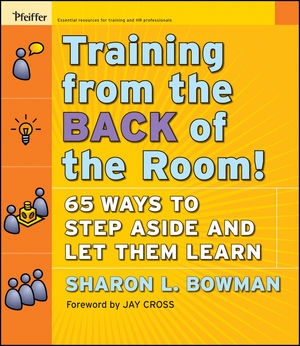Training From the Back of the Room!: 65 Ways to Step Aside and Let Them LearnISBN: 978-0-7879-9662-8
Paperback
320 pages
December 2008, Pfeiffer
 |
||||||
NEED-TO-KNOW INFORMATION FROM THE FRONT OF THE BOOK.
Warm-Ups for Training from the BACK of the Room!
The 4 Cs Reference Guide.
What’s In It For You? An Introduction to Training from the BACK of the Room!
Imagine That . . . .
Do You Want Them to Hear It or Learn It?
Who’s Doing the Talking?
The Power of the Paradigm.
This Book Will Get You There.
How This Book Is Organized.
Using the Thing to Teach the Thing.
Brain-Friendly Training: Learning About Learning.
Imagine That . . . .
From Boring to Benefi cial.
Brain-Friendly Learning and Training.
Positive Emotional Experiences: From Emotions to Attention to Learning.
Multi-Sensory Stimulation and Novelty: Timing and Movement.
Instructional Variety and Choices: Reaching Most of the Learners Most of the Time.
Active Participation and Collaboration: Stepping Aside While Letting Them Learn.
Informal Learning Environments: “Do Not Touch” Versus “Make Yourself at Home”.
The 4 Cs: A Quick and Remarkably Effective Instructional Design Process.
Imagine That . . . .
The 4 Cs and Accelerated Learning.
Design and Delivery Reminders.
PART ONE: CONNECTIONS.
What You Need to Know About Connections.
Imagine That . . . .
Connecting Learners to Learners.
Connecting Learners to Topic.
Connecting Learners to Personal Goals.
Connecting Learners to Outcomes.
The Primacy-Recency Principle.
Connections, Not Icebreakers.
Connections: Warm-Up Activities.
What Is a Warm-Up?
What Does a Warm-Up Do?
Getting Ready.
Five Warm-Up Activities.
Your Turn.
Connections: Fast Pass Activities.
What Is a Fast Pass?
What Does a Fast Pass Do?
Getting Ready.
Five Fast Pass Activities.
Your Turn.
Connections: Start-Up Activities.
What Is a Start-Up?
What Does a Start-Up Do?
Getting Ready.
Five Start-Up Activities.
Your Turn.
PART TWO: CONCEPTS.
What You Need to Know About Concepts.
Imagine That . . . .
Teach Only the Need-to-Know Information.
Provide Graphic Organizers.
Apply the Ten-Minute Rule.
Use Interactive Lecture Strategies.
Include One-Minute Reviews.
Concepts: Concept Maps.
What Is a Concept Map?
What Does a Concept Map Do?
Getting Ready.
Five Concept Maps.
Your Turn.
Concepts: Interactive Lecture Strategies.
What Is an Interactive Lecture?
What Does an Interactive Lecture Do?
Getting Ready.
Five Interactive Lecture Strategies.
Your Turn.
Concepts: Jigsaw Activities.
What Is a Jigsaw?
What Does a Jigsaw Do?
Getting Ready.
Five Jigsaw Activities.
Your Turn.
Concepts: Concept Centers.
What Is a Concept Center?
What Does a Concept Center Do?
Getting Ready.
Five Concept Center Activities.
Your Turn.
Table Center Examples.
PART THREE: CONCRETE PRACTICE.
What You Need to Know About Concrete Practice.
Imagine That . . ..
What Concrete Practice Is Not.
Mistakes Are Allowed.
Elements of Effective Practice.
Concrete Practice: Teach-Back Activities.
What Is a Teach-Back?
What Does a Teach-Back Do?
Getting Ready.
Five Teach-Back Activities.
Your Turn.
Concrete Practice: Skills-Based Activities.
What Is a Skills-Based Activity?
What Does a Skills-Based Activity Do?
Getting Ready.
Five Skills-Based Activities.
Your Turn.
Concrete Practice: Learner-Created Games.
What Is a Learner-Created Game?
What Does a Learner-Created Game Do?
Getting Ready.
Five Learner-Created Games.
Your Turn.
PART FOUR: CONCLUSIONS.
What You Need to Know About Conclusions.
Imagine That . . . .
Learner-Led Summaries.
Learner-Focused Evaluations.
Learner-Created Action Plans.
Learner-Led Celebrations.
Conclusions: Learner-Led Summaries.
What Is a Learner-Led Summary.
What Does a Learner-Led Summary Do?
Getting Ready.
Five Learner-Led Summaries.
Your Turn.
Conclusions: Evaluation Strategies.
What Is an Evaluation?
What Does an Evaluation Do?
Getting Ready.
Five Evaluation Strategies.
Your Turn.
Conclusions: Celebrations.
What Is a Celebration?
What Does a Celebration Do?
Getting Ready.
Five Celebration Activities.
Your Turn.
NICE-TO-KNOW INFORMATION FROM THE BACK OF THE BOOK.
The Secret of Adult Learning Theory: It’s NOT About Age!
Once Upon a Time.
Pedagogy Versus Andragogy.
Adults Versus Children.
From Adult Learning to Human Learning.
Bringing It Home to What You Do.
Begin with the End: A Fresh Approach to Learning Outcomes.
What You See Is What They Learned.
What They Need to Know.
Use the Formula, Baby.
Real Outcomes for Real Training.
Back to the Beginning.
The World Cafe: An Innovative Process with Conversations That Matter.
Welcome to The World Cafe.
What Is TWC?
Origins of TWC.
Cafe Design Principles.
Where to Begin.
Final Reminders.
Wake ‘Em Up! Ten Tips for Interactive e-Learning.
1. Send Out Warm-Ups with Built-In Accountability.
2. Create an Interesting Graphic Organizer.
3. Begin with a Fast Pass.
4. Follow the Ten-Minute Rule.
5. Build in Body Breaks.
6. Become Familiar with Interactive Features—And Use Them.
7. Lengthen the Learning with Follow-Up Action Plans.
8. Follow Up with Blogs or Wikis.
9. Give Them Changes and Choices.
10. Go with the Flow.
Putting the Tips to Work.
The Author’s Epilogue.
The Orange Juice Cure.
Be the Change You Seek.
Teaching Is Learning, Learning Is Teaching.
Great Resources.
Author’s Note.
Need-to-Know Books: The Author’s Top Five.
Resources Cited in Training from the BACK of the Room! (Most from the 2000s).
Other Resources (from the 1990s–2000s).
Extra Resources.
A Word of Thanks.
About the Author.



